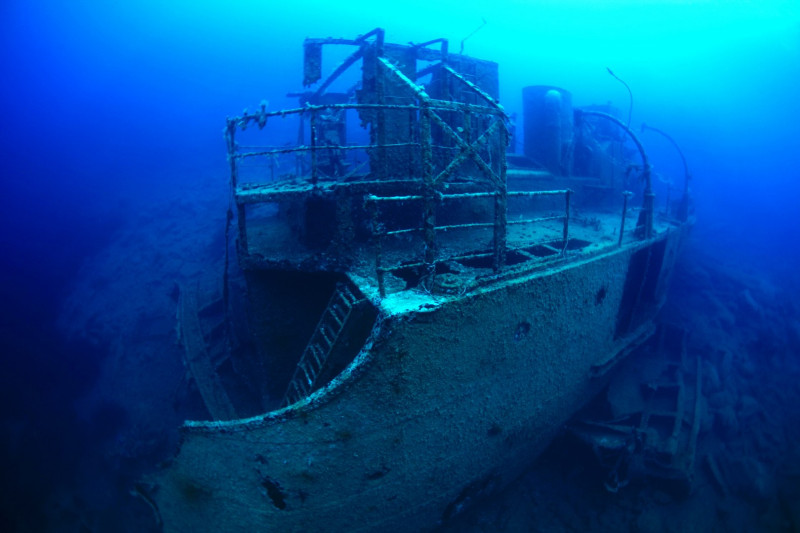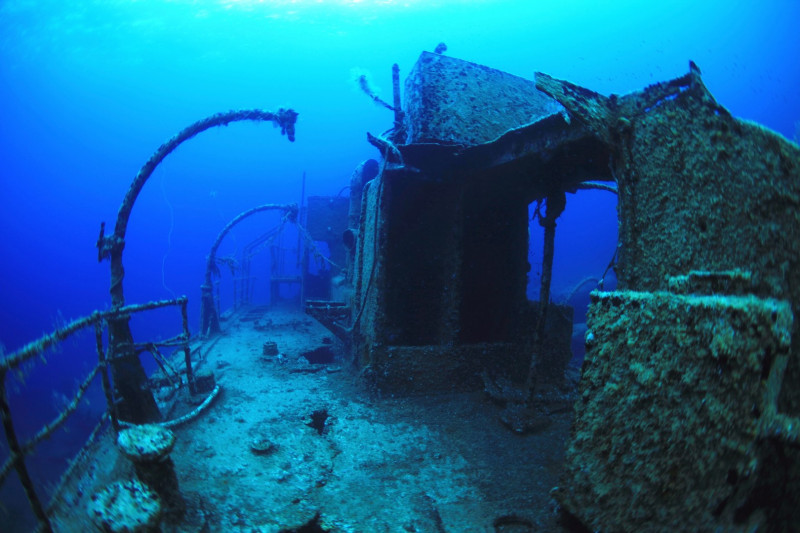Most of the wrecks are located at accessible depths (up to 40 meters), are in very good condition and are found both in the northern and southern parts of the island
Impressive images of six modern shipwrecks lying on the seabed of Karpathos have been brought to light by the research team Kostas Thoktaridis which, in collaboration with the Municipality of Karpathos, recorded for the first time the modern shipwrecks of the area.
“Under the waters of the island hides a wild beauty of special geological formations that, with their otherworldly image, compose a mysterious scenery, becoming a pole of attraction for every diver,” says Mr. Thoktaridis to APE-MPE. He points out that the underwater world of Karpathos is special and full of surprises as there was a passage of warships and submarines during the Second World War.
Most of the wrecks are located at accessible depths (up to 40 meters), are in very good condition and are found both in the northern and southern parts of the island. Some of the sunken ships are of special shipbuilding, they were built before the war and survived the Second World War before ending up years later at the bottom of Karpathos.
The identity and history of ships
Jupiter under Mount Olympus of Karpathos
The motorship DIAS was built in the Netherlands in 1951. The ship had sailed from the port of Stylida on March 24, 1989 with a load of bricks on pallets, total weight 680 tons, with the final destination Pigadia of Karpathos.
The ship sank on March 29, 1989, and at a distance of 1.5 miles north of Diafani bay, below the famous settlement of Olympus, due to the great inclination it had taken. There were no victims. The wreck is located on a sandy bottom 24 meters deep. The stern part rests on the bottom with the right side, while due to the exceptional purity of the waters of Karpathos, the wreck can often be observed from the surface with a mask. The massive load of bricks it carried has become a refuge for the local fish.
NITALKO
A World War II veteran. In 1938 a river and coastal liner was built at the Ewald Berninghaus shipyards in Cologne, Germany for Hamburg-based Hermann Knütel. The motorship was commissioned by the German Navy on November 27, 1939 and initially served as a torpedo carrier under the Kiel Naval Station. The ESTE was one of at least twenty similar vessels sent in 1942-1943, via the great rivers of Central Europe, to the Black Sea to reinforce German military action in the area.
When the Soviet Army pushed the German forces westward, leaving these ships out of their role and in danger, it was decided to advance to the Aegean through the Straits, in order to contribute to the ongoing German operations in the Greek area.
In the afternoon of January 10, 1944, the ESTE together with the motorships SEERÄUBER and VERA left Leros for Rhodes. ESTE was empty of cargo, SEERÄUBER carried eighty soldiers and VERA carried oil. Following a westerly course to avoid any encounter with enemy vessels, they sailed to Livadia of Tilos to spend the night and sail in the morning to Rhodes under the cover of the German air force.
During the night, between 03.00 and 04.00, three British torpedo boats entered the bay and opened fire on the German ships. Fires broke out on the ESTE and VERA which soon sank, while the master of the SEERÄUBER ran her aground to prevent her sinking.
The wreck of ESTE was raised in 1947 and sold to private individuals who renamed it TILOS. TILOS traveled for years, ran aground at the mouth of the Alpheios river where it was abandoned by its crew. However, the vessel was raised and in 1968 returned to active duty as KALI ARHI.
Re-sold in 2004 and renamed NITALKO flying another flag, North Korea. On February 26, 2007, the motorship was sailing from Rhodes to Crete loaded with a cargo of granite that it had loaded in Turkey. Near the island of Saria after a cable got stuck in the propeller it was left unruly in gale-force westerly winds. The crew of three Turkish and two Russian sailors raised a distress signal and were picked up safely by an Air Force Super Puma helicopter.
The NITALKO then drifted aground and a breach was created in the middle of the flat. The next day he was absent from his position and as the searches in the area were fruitless it was estimated that he had sunk.
The wreck of NITALKO is in excellent condition resting on the bottom on its starboard side. The bow is at a depth of -40 meters and the stern reaches almost -20 meters. It is located next to a rocky reef on the northwest side of the island of Saria in Karpathos. Its holds are filled with cobblestone granite and tiles.
CEMENT a samurai at the bottom of Karpathos
Built in 1969 at Tsuneishi Shipyards, Japan. The end of the ship came on May 25, 2003 when it ran aground on a reef in the Kasos – Karpathos strait. The damage suffered by the vessel did not allow it to be raised and it was abandoned with the commode and loading mechanisms remaining above the surface of the sea.
With the passage of time, the boat could not withstand the pressures and corrosion, causing it to break and sink.
The shipwreck is located on the rocky reef of Karpathos, in the strait between Kasos and Karpathos. The Sea area is known for strong waves and strong sea currents, on the other hand for extremely clear blue waters.
The maximum depth does not exceed -15 meters.
The bow has literally dissolved and on the bottom you can see the winches, the anchor chains and the spare anchor.
The fins around the engine room no longer exist and the underwater visitor can swim between the ship’s engine and the generator, he will see up close the distortions in the propeller blades and shaft.
GERNIK
A German minesweeper of the war with a multi-dimensional history
The cargo ship Gernik was built in 1939 at Lübecker Maschinenbau, Germany, for the Hamburg company A. Kirsten and was originally named CRESSIDA.
In 1939 the German navy gave it the name V.102, (Vorpostenboot.102) it took part in the battle of Norway.
In 1940, it was converted into a minesweeper. It was built with a narrow bow nose, so it could relatively easily enter mined areas.
The ship in May 1945 was surrendered to the Americans, but in October 1947 she was transferred to the Dutch and returned to her civilian duties as ELSENBURGH, a name given to the ship from the Dutch region of the same name, on behalf of Wm.H.Muller & Co.
In 1952 the boilers were removed and a diesel engine was installed as a means of propulsion.
She mainly ran the Casablanca – London route, carrying goods, and has extensive references in the National Archives of Great Britain.
Sold in 1961 to Liberian based Seven Seas Shipping Corporation and renamed GERNIK.
It was the eve of the holidays, early Sunday, December 23, 1962, when the ship Gernik, ran aground in the waters of Karpathos on the beach of Diakoftis after a severe storm.
Today it is amorphous, rusted iron, sunk at a depth of 14 meters. The stern is wedged into the rocks with a slight right angle. The special majestic bow rests on the bottom with the anchor chains absent from the portholes.
The ship’s sheets are unusually thick and there are places where the riveted sheets of 1939 can be seen.
TENARON S
An Englishman in 1935 in the waters of Karpathos
She was built in 1935 under the name GLEN at R & W Hawthorn, Leslie & Co Ltd., Hebburn, England for the British Tyne-Tees Steamship Co.
His company was based in Newcastle.
GLEN had a total capacity of 471 tons, dimensions 50.4 x 8.3 meters. After the end of the war the GLEN was renamed the BELGIAN COAST. LAIRDSROCK acquired a new engine in 1957 and continued to sail until 1966 when it was acquired by Pericles Varvate & Co. and flying the Greek flag was renamed GIORGIS.
In 1979 the boat came under the co-ownership of “Lefteris D.” (Thira Shipping) and was renamed LEFTERIS D. But a year later it was sold to the Panamanian Etna Maritime Co SA and took the name TENARON S.
On 10 December 1980 the TENARON S. was traveling from Italy carrying a cargo of cigarettes when it ran aground on the coast of the Carpathos and sank.
RES-EMP
Read the News today and get the latest news.
Follow Skai.gr on Google News and be the first to know all the news.
I am Terrance Carlson, author at News Bulletin 247. I mostly cover technology news and I have been working in this field for a long time. I have a lot of experience and I am highly knowledgeable in this area. I am a very reliable source of information and I always make sure to provide accurate news to my readers.












